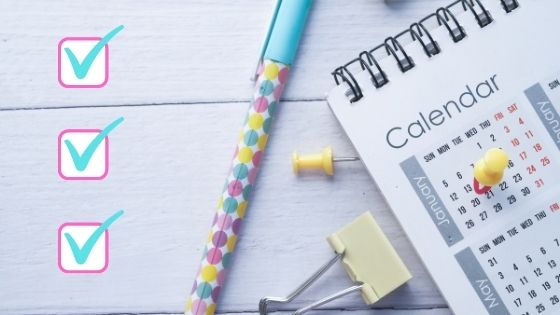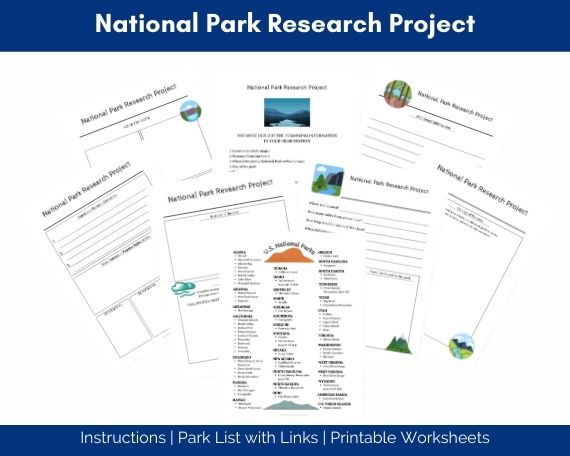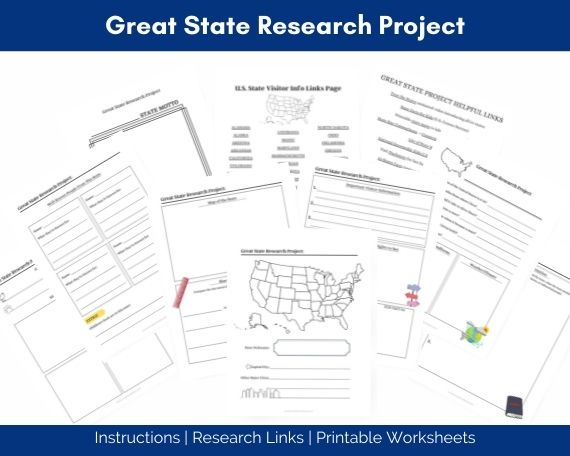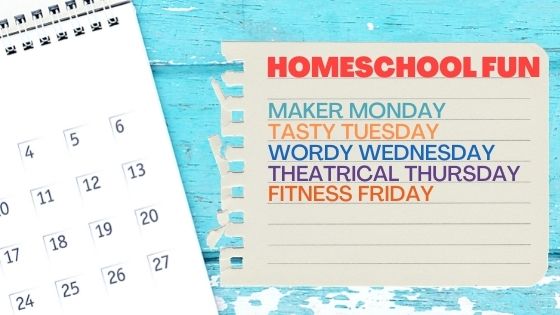Why You Should Use a Monthly Checklist
Checklists are a proven, effective way to organize tasks that need to be accomplished. This monthly checklist for household and homeschool planning will help you track those necessary tasks that tend to be overlooked. These are items that can be done on a monthly basis to organize your household tasks, prioritize and plan for the following month, make time for what’s important to you, and evaluate how things are going.
By spending a few hours each month maintaining an organized system, you will reduce the stress that results from feeling that your life is chaotic and disorganized. You’ll identify what’s working and what could use some improvement. And you will intentionally choose how to spend your time.
For a complete set of monthly checklists, monthly household planning pages, monthly homeschool planning pages, and monthly homeschool evaluation pages, check out my Monthly Checklists for Homeschool Moms.

How to Implement a Monthly Checklist System
Choose a Time to Plan
The first thing you will need to do is decide on a regular time that you will follow through on your checklist. Set aside a specific time to plan and organize each month. My suggestion is to do this at least a week before the end of the month. That allows enough time to plan ahead for anything coming up at the beginning of the next month, and work through any monthly tasks that still need to get done. Choose a time that you will be able to stick to most months, and allow a couple of hours to plan ahead and tackle once-a-month tasks.
Schedule a recurring task/appointment on your calendar for your monthly checklist, or pencil it in your planner.
Consult Your Checklist Weekly
You’ll want to consult your checkout throughout the month to make sure you’re on track with things you wanted to accomplish. Some things you can do at any point during the month and check it off (e.g. clean out your purse or check in with a friend). If you wait until the end of the month to tackle every task on your list, it will feel overwhelming and unattainable. Check-in with yourself weekly to make sure you’re on track, and then adjust as needed.
IMPORTANT REMINDER
These lists are intended to be guidelines and gentle reminders. Don’t fret if you don’t get the fridge cleaned out or your phone decluttered every month. Just check in again next month and make those things a priority. This checklist is a tool to be used by you, not to rule over you.


Monthly Checklist Categories
Below are the general categories that I use to create my monthly checklist. You may have additional categories that would be helpful for you. Consider tasks that pile up if you don’t stay on top of them. Anything that adds physical, mental or digital clutter to your life is a great candidate to add to a monthly checklist.
- calendar/planning
- meal planning
- general household tasks
- cleaning tasks
- financial/paper clutter tasks
- technology tasks
- family & friend connections
- personal care/personal development
- homeschooling
You can download this free printable checklist and gain access to my free printables library when you join my mailing list below.
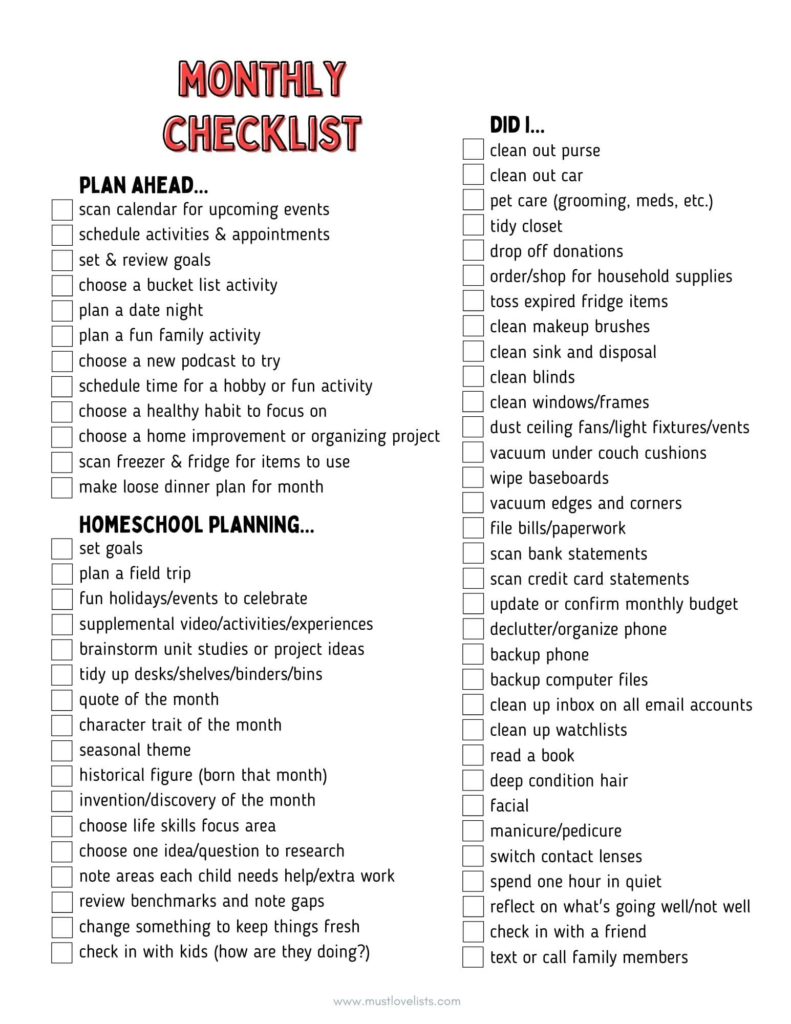
GENERAL CALENDAR & PLANNING
This is a big one. Spend some time at the end of each month to organize and plan your commitments and activities. You can’t plan everything, obviously. Life happens, and one of the things you should look at during your monthly planning session is that you’ve allowed enough “free time” in your schedule to accommodate adjustments.
1 // Scan the calendar for upcoming events
Look ahead for upcoming holidays, birthdays, or vacations that will need prep work. You may need to add birthday cards or gifts to your shopping list, start a packing list, or choose some fun holidays to celebrate with your kids.
2 // Schedule everything you can
Look ahead at the next month and schedule on your calendar every appointment or activity that you can. If you’ve been putting off a dental appointment, schedule it. Need a haircut? Get it on the calendar. Here are some possibilities for things that you can schedule ahead of time to make sure you allow the time for them:
- medical/dental appointments
- haircuts or other personal appointments
- playdates for kids
- coffee with friends
- time to shop for birthday gifts
- workout sessions
3 // Set monthly goals & review year-to-date goals
If you are one of the unicorns who manage to make New Year’s resolutions and stick to them all year, you may not need to set monthly goals. But, if your resolutions are usually abandoned by February, monthly goals can help keep you on track. You may want to choose one personal goal and one work-related goal.
If you have a big goal like learning a new software program, or losing weight, choose a small piece to focus on each month, and make it actionable. So for learning something new, your goal might be to watch one YouTube tutorial each week, or to spend 30 minutes per week taking a course or practicing. For losing weight, your monthly goals might be to prep healthy lunches weekly or eat five servings of vegetables daily.
Help your kids learn how to set goals with my goal-setting printables for kids
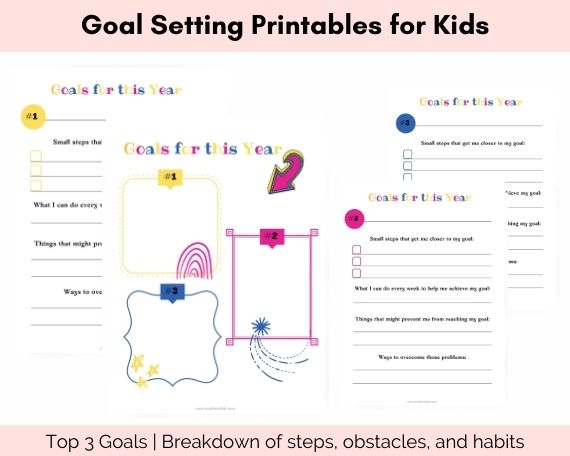
4 // Choose a home improvement or organizing project
You know all those pesky projects that just never seem to get done. It’s still a challenge, but choosing one to work on each month has helped me work through a few of those tasks that keep getting pushed to the end of my to-do list. If you don’t already have a list of household projects, take a minute to jot down all the little (and big) projects you want to accomplish around the house. Anything from remodeling the bathroom to cleaning out the junk drawer.
Then, choose one thing to work on each month. For a big project like remodeling a bathroom, you obviously need to break it down into smaller tasks. You may take a month to research ideas and estimate costs. That alone will be a step toward accomplishing your task.
PLAN FOR FUN
It seems counterintuitive, but planning for fun is important because we often get stuck in a rut of doing the same things over and over again, or mindlessly watching hours of TV that really doesn’t engage us in a meaningful way. Make an effort to plan fun that is meaningful to you and engages your family in making memories.
5 // Choose a bucket list activity to do
Every month, I try to choose a few bucket list activities to do either on my own or as a family activity. You can find an example of my bucket list activities in my What to Do in April post. These can be seasonal flavors to enjoy, a self-care routine to try, or a holiday-related activity. I have a printable pack of monthly planning lists in my Etsy shop that includes fun holidays to celebrate each month and a bucket list of activities, along with pages to list additional projects or priorities.
6 // Plan a date night
I am admittedly not good at following through on date nights, but I keep trying! It used to work for us to have a “date night” in after the kids went to bed, but with kids getting older and staying up later, we are TIRED by the time they go to bed. I do believe in the value of staying connected with your spouse and playing together. Simple activities count!
Here’s a short list of ideas for date night (or day):
- listen to a podcast or audio book together
- get takeout and set the table for a candlelit dinner
- plan a vacation together
- movie night with popcorn
- have dessert and take a walk together
- go for a hike
- stargazing
- play a game
- wine tasting
- cook a meal together
- gift shopping together
- work on a project together
7 // Plan a fun family activity
With kids in sports and extracurricular activities, evenings and weekends can be busy. Fun family activities don’t have to be big or expensive, the goal is to build family bonds and make memories. Choose a family activity each month and spend some time having fun together.
Here are a few ideas for family fun activities:
- sledding
- game night
- playground day
- picnic
- bike ride
- cornhole
- water balloon fight
- outdoor movie night
- hike
- go out for ice cream
- scavenger hunt
- Christmas lights drive
Check out “How to Hold a Family Olympics” for a fun family activity your kids will love!
8 // Choose a new podcast to try
Podcasts are the perfect way to multi-task for those of us that really want to believe we can multi-task and get more done. (Truth: multi-tasking does not work for most things, but this is an exception.) While you’re folding laundry, chopping vegetables, or driving home after dropping kids at dance class, you have the opportunity to learn about almost anything through podcasts.
According to podcasthosting.org, as of April 2021 there are over 2 million podcasts with 48 million episodes available to your ears. That’s a lot. And even though most of them are probably not of interest to you, there’s still a lot of listening options to explore. That is why I like to choose a new podcast to try each month. Even after doing a little research and giving my best guess at what I might like, sometimes I listen to only a couple of episodes and decide it’s not for me. That’s ok. I’ve found several podcasts that I love just by consistently trying new ones.
My favorite type of podcast is an interview format in which each episode features a guest that has an interesting story to tell. I am fascinated by the human mind and love to hear from people who are passionate about something. Podcasts are like books, and taste is very individual, but here are a few that I’ve enjoyed. Search any topic you’re interested in, along with podcast (e.g. knitting podcast, home design podcast, dog training podcast). Seriously, you can find a podcast for anything.
General Knowledge/Interviews
- How I Built This
- The Tim Ferriss Show
- Stuff You Should Know
- Revisionist History
Christian Podcasts
- The Bible Project
- Made for This with Jennie Allen
- Journeywomen
- Happy Hour with Jamie Ivey
9 // Schedule time for a hobby or fun activity
This one is for you. Make sure you carve out a little bit of time for something you love. If you love classic movies, but your family does not, watch one by yourself. Let the kids turn on a Saturday morning cartoon while you spend an hour flipping through your favorite magazines. Schedule a time each month for you to improve your watercolor technique or browse a thrift store. Anything that relaxes or inspires you counts here.
10 // Choose a healthy habit to focus on
As life gets busy, I find that my healthy habits sometimes fall by the wayside. I stay up late to get things done and then my mornings feel rushed and I abandon my plans to drink water, stretch, pray, or otherwise start my morning off right. Choose a healthy habit to focus on each month, and make it a priority to keep that promise to yourself.
Read my 30-Day Challenge Ideas to Jumpstart Healthy Habits
MEAL PLANNING
11 // Scan freezer & fridge for items that should be used
Take a few minutes to scan your fridge, and maybe even your freezer, for items that should be used up. Move them front and center so that your family sees them, add them into your meal plan, or post a leftovers list on the fridge to remind everyone to eat these first!
Grab a free printable Leftovers List for your fridge here
12 // Create a loose dinner meal plan for the month
It feels like the moment you finish feeding the people in your house they need to eat again. You don’t have to plan every specific meal for the entire month if you prefer to meal plan weekly, but it can be very helpful to pencil in a loose meal plan in advance. Here’s what I mean by this.
Sit down with your calendar and look at what you have scheduled. Can you see that every Tuesday your family is racing from one activity to the next and you aren’t able to eat dinner together? You can plan for that. Make a note that Tuesdays you need to have a crockpot meal ready for everyone to serve themselves, or make a double batch of Monday’s dinner and label the leftovers for Tuesday. You don’t have to get stuck ordering pizza or eating fast food if you thoughtfully look ahead.
Whether you prefer to meal plan weekly or monthly, check out my meal planning bundle of printables. You’ll find weekly and monthly meal planning pages, pages to keep pantry and freezer inventories, favorite family meals, recipes to try, grocery list, and more. Plus, I’ve included a healthy snack list, easy no-recipe dinner list, breakfast ideas list, and a “Pack Your Lunch” printable to help your kids learn to pack their own healthy lunches. Click the image below to check it out.
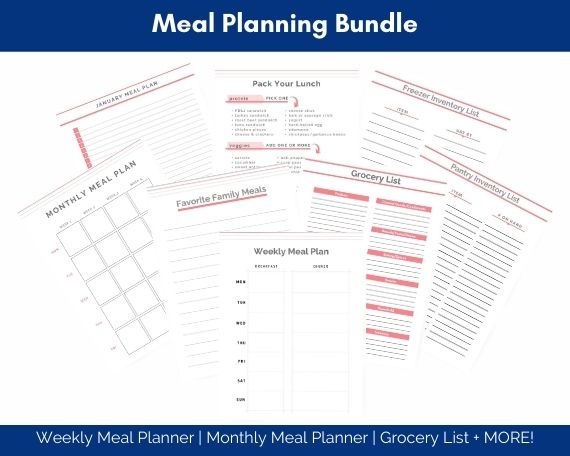
CHECKLIST ITEMS THROUGHOUT THE MONTH
These are the things you can check off throughout the month. I like to take some time on Sundays to scan the week ahead and plan for upcoming activities. Make it a habit to look over your monthly checklist weekly and check a few items off each week. Some of these lend themselves well to setting reminders on your phone. If that works for you, and you don’t ignore it and forget it, use reminders to notify you that it’s time to give the dog her flea medication or backup your phone to your hard drive or cloud storage service.
GENERAL HOUSEHOLD TASKS
- clean out purse
- clean out car
- pet care (grooming, meds, etc.)
- quick closet tidy
- drop off donations
- order/shop for household supplies
- toss expired fridge items
Join my mailing list for exclusive access to my printables library where you’ll find this household supply list!
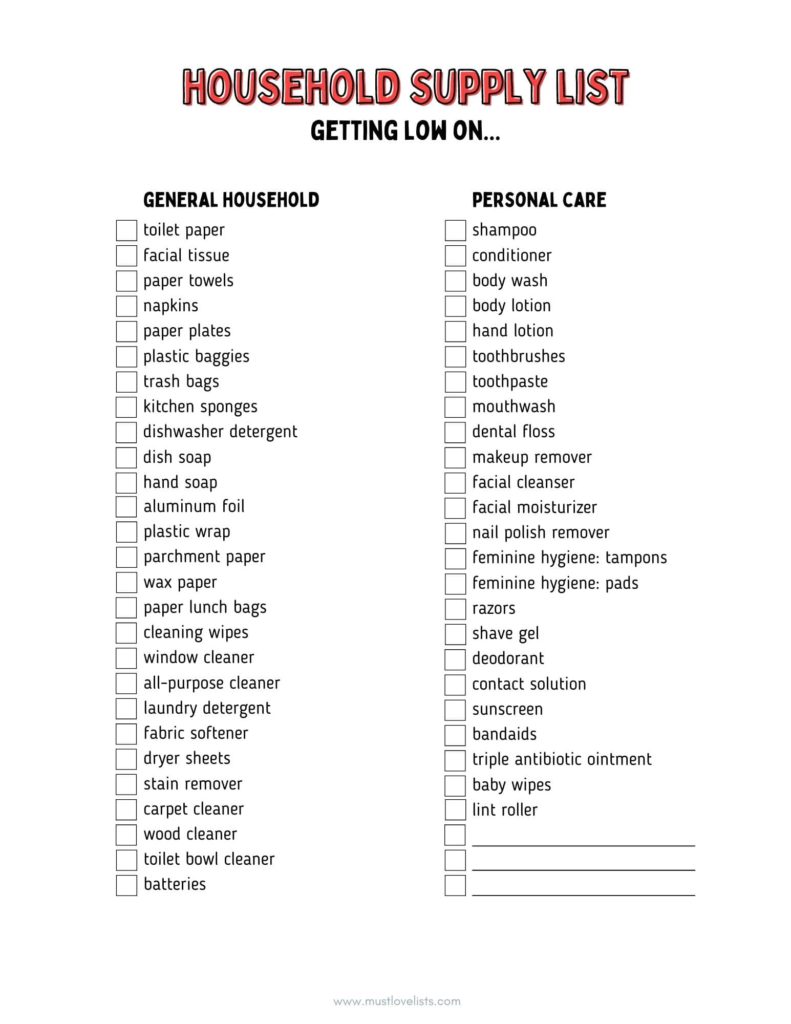
CLEANING TASKS
- sanitize makeup brushes
- clean sink and disposal
- wipe blinds
- clean windows/frames
- dust ceiling fans/light fixtures/vents
- vacuum under couch cushions
- wipe baseboards
- vacuum edges and corners of carpet
FINANCIAL/PAPERWORK TASKS
- file bills & other important paperwork: schedule or pay any bills not on autopay, file paperwork that should be kept (Suze Orman has a great list of how long to keep papers), label and file receipts needed for tax purposes
- scan credit card statements for errors: match charges on credit card statements with receipts if possible
- scan bank statements: look over your bank statements for errors and confirm accuracy of deposits and withdrawals
- update or confirm monthly budget: update any expenses or income that has changed in the past month, review allotments for discretionary spending
TECHNOLOGY TASKS
- declutter/organize phone
- backup phone
- backup computer files
- clean up inbox on all email accounts
- clean up watchlists (Netflix, Hulu, Prime, etc.)
Read How to Organize Your Phone for a useful checklist to help you clean up your digital clutter
FAMILY & FRIENDS
- check-in with a friend (phone call, lunch date, girls night out, etc.)
- text or call family members (grandma, sister, etc.)
PERSONAL CARE/PERSONAL DEVELOPMENT
- read a book
- spend at least one hour with no noise (no phone, music, TV, etc.)
- journal & reflect on what’s going well and what needs to change
- deep conditioning hair treatment
- facial
- switch contact lenses
- manicure/pedicure
Bonus for Homeschooling Moms…
MONTHLY CHECKLIST FOR HOMESCHOOL PLANNING
It may seem like adding more tasks to your plate when life feels crammed with to-dos already is a pointless undertaking, but I find that having a monthly checklist for homeschool planning helps direct and organize my efforts in a way that pays back the extra time it takes.
I have two types of monthly lists for homeschooling. Monthly planning tasks are intended to help you plan and organize, but hold them loosely as life happens and plans change. Then, a monthly check-in is intended to be used in conversation with your child as a way to think encourage reflection, identify problems, brainstorm solutions, and celebrate successes.
Here are my monthly checklist items for homeschool planning.
SET GOALS
Without goals, it’s hard to know whether we are making any progress. Goals provide a vision for what we want to see or experience. Specific monthly goals are helpful to move along a path toward a desired outcome. If you have a big goal of teaching your kids to resolve conflict without yelling at one another, you may set a goal for yourself to research conflict resolution techniques and be purposeful about teaching them to your kids next month.
You may set a goal around completing a specific unit study, spending 30 minutes a week listening to an audiobook together, or memorizing a passage of scripture. Spend a little time deciding what you would like to work toward on a monthly basis in your homeschool.
PLAN A FIELD TRIP
If you’re naturally a drop-everything-and-go mom, you may not need to intentionally plan for field trips. I’m not that mom. I need to intentionally plan for fun “field trip” activities. Sometimes you’ll have a field trip that corresponds beautifully to something your kids are studying, and other months you may just take a nature hike in your neighborhood or even try a virtual field trip to a famous museum.
If your kids enjoy a change of pace, anything new or out-of-the-ordinary will make their day.
FIND FUN HOLIDAYS TO CELEBRATE
My kids love celebrating National Jelly Bean Day of course, but there are a whole lot of fun holidays that can be worked into learning in an engaging way. Read 365 Fun Holidays to Celebrate with Kids to find a list of learning holidays to celebrate each month of the year, plus a whole year’s worth or silly, wacky holidays just for fun.
Click here for my list of holidays to incorporate in your homeschool each month of the year
LOOK FOR SUPPLEMENTAL LEARNING MATERIAL
I love to find fun video content, hands-on activities, or other experiences to amplify and supplement whatever my kids are learning. YouTube has a wealth of content on almost any subject. We use Google classroom, and my kids love to discover the video links I’ve hidden in a Google slide for them to find each week. TeachersPayTeachers is a great resource for games and activities related to a specific subject or topic as well.
Grab a printable list of learning resources for kids here
BRAINSTORM UNIT STUDY OR PROJECT IDEAS
Take a few minutes each month to think about what your kids are into right now and brainstorm a list of unit studies or project ideas that might be fun to do. You may also consider areas that your kids haven’t had much exposure to and add those to the list. Our family plans to visit a national park this year, so I had our kids do a national park research project.
TIDY UP HOMESCHOOL AREA
My kids are messy. They prefer to call it their zone of creative genius, but I still want the mess picked up. Take a bit of time once a month to tidy up those areas that get “tidied” by your kids…but not really. Now if they are older, they should definitely be involved in this process, but either way, those shelves, desks, bins, and binders need regular supervision.
CHOOSE ONE QUESTION OR RESOURCE TO RESEARCH
The information available to us is endless, and there is no way we can track and process every piece of it. I like to keep a list of questions, thoughts, ideas, or resources that catch my attention in some way. This might be a specific curriculum, a book, article, or simply an idea about changing our schedule or how we begin our day. Pick one item that you’ve been wanting to look into and put it into your calendar for the month. Accept that you cannot possibly learn about everything, and move forward with researching or making a decision about one item.
MONTHLY THEMES
I love to incorporate themes into our homeschool. Here is a list of some things we have done.
- quote of the month
- character trait of the month
- seasonal themes (back-to-school, fall, harvest, thanksgiving, Christmas, winter, Valentine’s Day, St. Patrick’s Day, Easter, spring, summer)
- historical figure: someone born in that month
- invention/discovery of the month: learn about something patented or discovered during that month, or an inventor born in that month
- life skill of the month (making beds, setting the table, using knives, cleaning toilets, doing dishes, grocery shopping, conversation, reading recipes, organizing clothing, doing laundry, peeling vegetables, changing a tire, changing a lightbulb)
Read Monthly Motivation for Kids to find monthly inspirational quotes + resources
There are endless possibilities for this. If you have kids who love sports, pick a player of the month to learn about, a chemical element of the month, a classic movie of the month. It’s a great way to develop a rhythm of expectation for having continuity month after month, while still generating excitement for them to wonder what animal/country/song of the month will be up next.
MONTHLY EVALUATION
- make note of specific areas each child needs additional help or work in
- review appropriate benchmarks and note areas that still need to be covered
- evaluate whether anything needs to change to keep things fresh: are your kids bored? disengaged?
- ask your kids what they like and don’t like: curriculum, schedule (or lack thereof), do they have any requests or suggestions?
Why You Should Try Using a Monthly Checklist
As a homeschooling mom, you have a lot on your plate. This monthly checklist definitely should not be used to make you feel guilty about all the things you aren’t getting done. Instead, use it as a guide to remind you to plan for family time, to pursue activities that bring you joy, and to regularly talk to your kids about how things are going.
I’m the first to admit I rarely get through all my checklist items in a month. But by using a monthly checklist, I know what tasks I’d like to accomplish. This means I don’t let too many months go by without decluttering my phone (Hello 3000 photos, where did you come from?) or vacuuming under my couch cushions!
Visit my homeschool resources page for monthly unit study ideas, projects, and homeschool planning help!

Join my mailing list to receive updates when new printable resources are added to the library, plus tips and encouragement for your organized homeschool journey.

